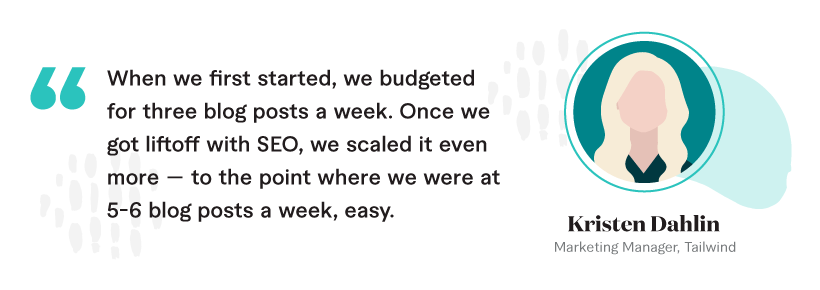Scaling content production includes activating many moving parts, from keyword research to content writing to search engine optimization (SEO). Each part requires a lot of attention and expertise to publish content that resonates with your audience and attracts traffic. It can feel like a juggling act!
Most companies go through some growing pains while they figure out how to scale their content production without sacrificing quality.

According to the Content Marketing Institute, Content marketing generates three times as many leads as traditional outbound marketing but costs 62 percent less.
That’s pretty cost-effective! But how do you ensure to maximize the impact of your content marketing team?
In this comprehensive guide, we’ll cover the challenges to increasing your team’s impact, the benefits of optimizing your team, and tools you can use. Then, we’ll discuss some automation strategies for streamlining and collaboration strategies for effective communication.
Facing the Challenge of Increasing Your Team’s Impact
Teams regularly choose to grow their headcount to maximize content marketing impact. But not only can that be costly, it doesn’t guarantee the experience necessary to create the impact you want.
Kristen Dahlin, the Marketing Manager for the Tailwind social media app, faced this problem in 2020. “We were going over our strategy for the year,’ she says, ‘and noticed how our competitors in the space were killing it at SEO.”
The biggest issue with Tailwind’s SEO wasn’t optimization or quality. It was simply an issue of quantity. “We were doing one blog post a week, and in our competitive analysis, we saw our competitors putting out one a day, just absolutely dominating the space. We quickly realized we needed to ramp up content.”
At the time, Dahlin was operating solo in an under-resourced department. Producing daily content simply wasn’t viable, but she found the solution in outsourcing. She ramped up production effortlessly by working with Clearvoice to develop the right group of freelancers.
She says, “When we first started, we budgeted for three blog posts a week. Once we got liftoff with SEO, we scaled it even more — to the point where we were at 5-6 blog posts a week, easy.”
Outsourcing enabled Tailwind to scale its content competitively without adding staff. In this ebook, we’ll explore outsourcing along with other strategies you can use to optimize your content marketing team and get the best results from your budget and time.
Benefits of Optimizing Your Team Without Increasing Headcount
Improved and increased content quantity
As we saw with Tailwind, you can scale your content production without increasing your staff. This leads to a circle where you can produce more content and attract more traffic, which leads to more opportunities for revenue generation — and you can reinvest some of that revenue in more content production.
Further optimizing your team also allows you to attract better talent and use each person’s expertise in the areas where they are best suited. As a result, you can focus more on research, strategy, and other aspects that lead to more engaging content.
Reduced time to market
A streamlined team is a fast team. Optimization strategies help you get content out faster to catch trending keywords on the upswing instead of your content arriving late to the party.
Lower costs
The costs associated with staff are staggering. Benefits, workspace, equipment, training, software licenses, motivation programs — the expenses go far beyond payroll. When you don’t increase headcount, your costs remain the same — or potentially even decrease over time. This helps with budgeting and leaves more room for other marketing strategies.
Increased ROI
With better content quality, increased quantity, and faster production times, your investment in content marketing is more likely to bring a positive ROI.
Less stress on you and your team
Optimizing your content production system can reduce stress for everyone involved. It allows you to produce more without sacrificing quality, which leads to more job satisfaction and better team morale.
Being efficient with your existing staff is one of the most effective ways to scale your content marketing without breaking the bank. The strategies outlined in this ebook will help you make the most of what you have — and enable you to deliver better results without increasing headcount.
Maximize your content team’s impact without additional headcount with our in-depth workbook!
Tools, Processes, and Strategies to Optimize Your Existing Team
The right tools and processes can make a huge difference in optimizing your team. Here are some of the best strategies you can use:
The proper (limited) role of AI
We’re hearing a lot about AI these days. But can a bot really write content for you?
While AI can create a blog post on just about any topic, those posts must be compelling enough for readers and search engines. And AI-written content tends to contain a lot of fluff, cliches, and tired ideas.
But the main problem is AI can’t connect with readers on a human level. The posts it creates tend to fall flat. AI-written copy sometimes even contains unreliable facts and made-up quotes (Yikes!)
However, there is a place for AI tech in content creation. Start with our marketer’s guide to AI-supporter content creation to see where to best implement it.
Communication and project management tools
Project management and communication software can help you streamline your content production. A sound system keeps all your details in one place, facilitates collaboration between teams, and gives you the status of each project at a glance.
Some project management tools that work well for content production include:
- Trello: This card-based system lets you assign people to tasks and create calendar-based automations. Cards can have checklists, due dates, and notes. You can create templates for cards and view them in calendar or task list modes, as well as Kanban-style boards.
- Asana: Great for project-based thinking, with tasks and subtasks within each project. You can assign tasks to team members, set due dates and reminders, and communicate with your team inside the system.
- Monday: Gives you a visual overview of your project with one-click communication. With customizable views and flexible boards, this system makes it easy to keep track of your content production process.
These tools can help you stay organized and save time throughout your content production process.
Writing tools
Good writing tools will help you work as a team to produce clean, readable content that satisfies search engine bots and readers alike. Here are some great writing tools that can help you with this:
- Grammarly is a popular online editing plug-in that can help detect grammar, spelling, punctuation, and tone errors. It also allows you to save your settings so the app will check all future documents against the same standards.
- Google Docs allows for real-time collaboration between multiple writers and editors. You can communicate about edits in suggestion mode and leave messages for your teammates. Google Docs is compatible with Grammarly and other plugins as well.
- Yoast SEO is a WordPress plugin that helps you optimize your content for SEO. It helps you create posts that are readable, targeted, and optimized.
- Hemingway Editor is a writing tool that helps you identify complex sentences, passive voice, and other issues. It can make your content easier to read and understand by adding clarity to your writing.
- ProWritingAid is an AI-assisted tool for advanced writers. This program helps you identify long sentences, wordiness, and other areas that need improvement. It also offers an AI-based writing mentor to help you develop your skills.
Keyword research tools
If you want your content to have the maximum reach, it’s crucial to have a strong keyword strategy. Keyword research tools can help you streamline the process of identifying the best keywords for SEO success and ensure that as many readers see your content as possible.
- Google Keyword Planner is a popular tool for finding the right keywords for your content. It can help you see which words have the highest search volume and competition and identify related terms that your writer could include in your post.
- Ahrefs is another tool that can help you quickly find the most relevant keywords for your topic. In addition, it allows you to track keyword performance over time and even generate keyword ideas based on what competitors are already ranking for.
- Semrush is another popular tool that can help you track keyword performance and view data on competitor content. It’s excellent for creating a comprehensive SEO strategy and staying ahead of the competition. Semrush also includes some writing and ideating tools.
Templates for content briefs
A detailed content brief template is a tool that will speed up your ideation process and make collaboration with your writers much easier. Project management tools like Trello and Asana make it easy to create templates, but you can also create them in word processing apps like Google Docs or Word. Here are some items to include in your template:
A content brief template saves time and ensures consistency across your content.
Automation Strategies to Streamline and Maximize Efficiency
Once you’ve collected the best tools, processes, and strategies, look for opportunities to automate as many tasks as possible. Automation will help you get the most out of your content marketing program without increasing headcount.
Use automation
Project management tools like Trello, Asana, and Monday have built-in automations that can save you a lot of time. Most businesses aren’t using these automations to their full potential. Digging deep into your apps and discovering all the automation features available is well worth the learning curve.
Keep scheduling consistent
Recurring tasks are everyone’s best time management tool. So, when setting up your content marketing schedule, be sure to create regular schedules that can be managed by all staff and contractors using recurring task tools and apps.
For instance, you may have someone in-house assigning briefs on the first of each month. If those briefs go out to a stable of freelance writers, avoid random assignments and due dates. If a writer knows they will have deadlines from you every Wednesday and Friday, they’ll save space in their schedule for you each week. You’ll have fewer requests for deadline extensions and a smoother-running content machine that way.
Automate content sharing
Many smaller businesses are still manually sharing posts on social media — and even larger companies aren’t always using all the features of their social apps.
Apps like MeetEdgar, HootSuite, and Buffer let you create sharing schedules, content categories, and libraries filled with content. Once you’ve set your schedule, all you have to do is top up the content library in each category periodically, and the app will do the rest.
Collaboration Strategies to Ensure Effective Communication
Besides automation, collaboration is vital to efficient content marketing. Whether you’re working with an in-house team or outside contractors, these communication and collaboration strategies will ensure smooth workflows and high-quality content.
Onboarding
Contrary to popular belief, onboarding is for more than just new employees. You should also assign onboarding checklists to any new content creators — especially freelancers. This will ensure they know what’s expected of them from the start and can get up to speed quickly.
Create a guide for new staff that offers a thorough overview of your processes, expectations, brand identity, and goals.
Feedback loop
People thrive when given detailed feedback on what they’re doing well and what they can improve. This is usually built into the supervisory and review systems for employees — but how will you give and receive feedback from contractors? Freelancers often labor for years without ever hearing that they’re doing a good job or receiving suggestions for improvement. Building in some communication flow will help you attract and retain the best content creators you can afford.
Brand and editorial guidelines
A comprehensive set of writer’s guidelines can save your writers and editors a lot of time. Be sure to include items like your mission statement and company culture, tone of voice and brand identity, top competitors, topics you cover, acceptable research sources, and the process for submitting drafts and getting paid.
The more detailed your guidelines, the better — but don’t let them become a bloated sourcebook that writers never have time to read. Keep it concise and updated with everything in one document so your writers know where to find what they need.
Checklists
Checklists are a simple but robust tool for ensuring no one overlooks a task. You can include a checklist for your writers in every brief, add a checklist for editors to your project management tool, and use checklists to hire talent, evaluate ideas, and track goals.
Scaling content without headcount is possible
Scaling your content marketing without increasing staff headcount may seem impossible. But if you engage the proper automation, systems, strategies, and tools, you can achieve great results. Reach out to ClearVoice today to learn more about how we
can help you achieve your content marketing goals.
Maximize the Impact of Your Content with ClearVoice
Many companies are turning to ClearVoice to help them scale content without increasing payroll. We offer a range of solutions that can help you find the right freelancers, shape your content marketing strategy — or even take the entire content production process off your plate.
With ClearVoice as your partner, our team of experts will ensure you have a steady stream of engaging, pro-quality content optimized for your brand’s unique goals. We help you unlock the full potential of your content team and resources while saving time and energy, freeing you up to focus on other priorities. Discover our solutions or talk to a specialist today to start seeing results.
Maximize your content team’s impact without adding headcount with our in-depth workbook. Download today!












